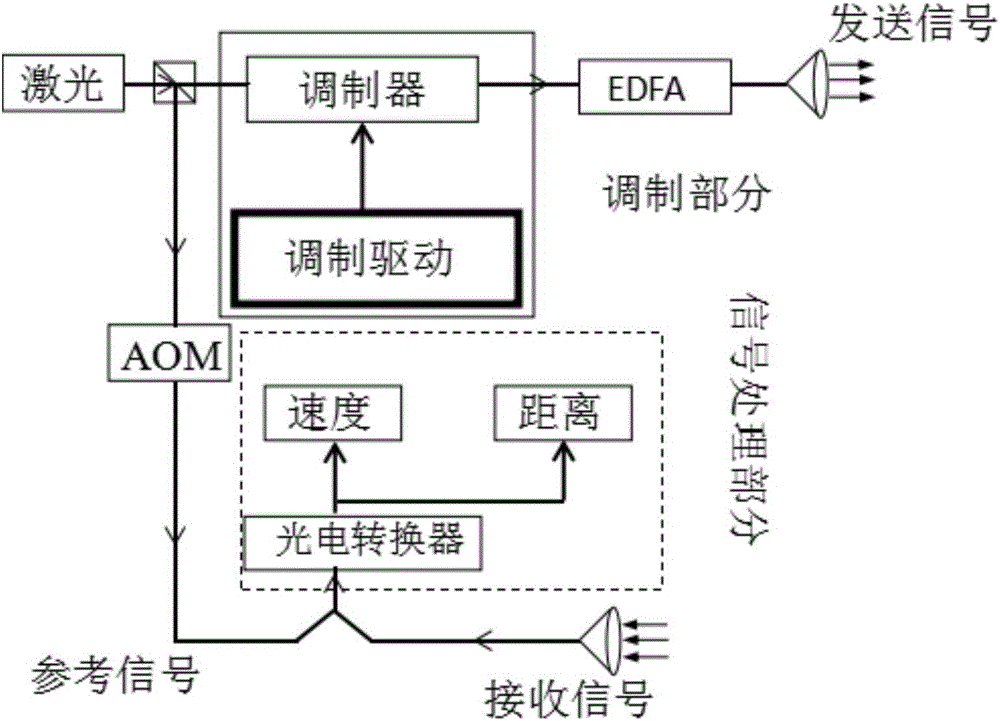Vehicle laser radar distance and velocity measurement method
A vehicle-mounted laser radar and speed measurement technology, which is applied in the field of laser radar, can solve the problems of increasing the maximum speed, etc., and achieve the effects of increasing range, reducing equipment cost, and improving use efficiency
- Summary
- Abstract
- Description
- Claims
- Application Information
AI Technical Summary
Problems solved by technology
Method used
Image
Examples
example 1
[0095] The modulation code width is set to 2ns, the signal length is 770ns, and the Doppler frequency of the received signal is 129MHz. Calculate the correlation function between the heterodyne signal and the modulation code, and observe that the peak value of the correlation function is affected by the Doppler frequency modulation. The results are as follows image 3 shown by the dotted line. In the case of the same signal peak power, the peak value of the correlation function output by direct detection (the received signal is not modulated by Doppler frequency) is represented by the solid line. Because the modulation effect of Doppler frequency reduces the peak value of the output correlation function, but it is noted that the coherent detection local signal has an amplification effect on the received signal, and the actual detection performance is better than that of direct detection.
example 2
[0097] The distance detection performance is mainly determined by the peak value of the correlation function. In this embodiment, the difference between the largest peak value and the second peak value is investigated. The larger the difference value, the better the anti-noise performance. In addition, it can be seen from formula (9) that the instantaneous power of the output heterodyne signal is affected by the phase. In this embodiment, when the phase changes from 0 to 2π, the change of the peak value and the sub-peak of the correlation function, the results are as follows Figure 4 shown. Four typical values of 16MHz, 60MHz, 129MHz and 209MHz are selected for the Doppler frequency of the received signal, all of which are within the range of 15.5-209MHz. The results show that the difference between the maximum peak value and the secondary peak value is almost not affected by the phase, indicating that the randomness of the arrival time of the received signal does not affe...
example 3
[0099] This embodiment tests the feasibility of using the frequency spectrum analysis method for non-equally spaced sampling signals to analyze the frequency of Doppler signals. Also select four typical values of 16MHz, 60MHz, 129MHz and 209MHz, sample the signals of the four frequencies according to the sampling period of the modulation code width, correct the sampled data according to the formula (8), and then use the classic fast Fourier transform algorithm Perform Fourier analysis on the amplitude-corrected data to find the frequency of the Doppler signal. The analysis results are as follows: Image 6 shown.
[0100] Function and effect of embodiment
[0101] According to the vehicle-mounted lidar distance and speed measurement method involved in this embodiment, the narrow-linewidth single-frequency laser is a pulse sequence, which can improve the detection stability of the lidar and meet the laser safety use standards; on the one hand, the use of a single photoelectri...
PUM
 Login to View More
Login to View More Abstract
Description
Claims
Application Information
 Login to View More
Login to View More - R&D
- Intellectual Property
- Life Sciences
- Materials
- Tech Scout
- Unparalleled Data Quality
- Higher Quality Content
- 60% Fewer Hallucinations
Browse by: Latest US Patents, China's latest patents, Technical Efficacy Thesaurus, Application Domain, Technology Topic, Popular Technical Reports.
© 2025 PatSnap. All rights reserved.Legal|Privacy policy|Modern Slavery Act Transparency Statement|Sitemap|About US| Contact US: help@patsnap.com



